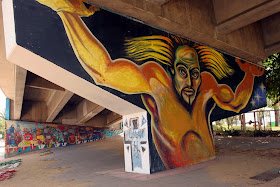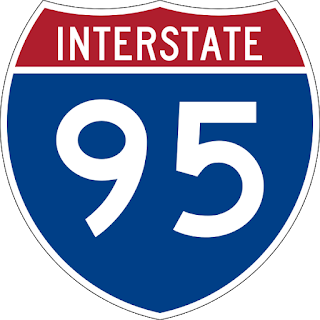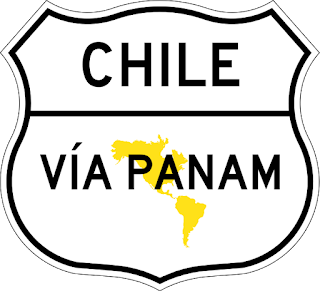 |
| (Flickr/CC) |
Logan Heights and Barrio Logan
Barrio Logan is an old San Diego neighborhood. It was first plotted in 1881 as a destination point for the transcontinental railroad into San Diego that was never built. As it became apparent the railroad would not be coming into San Diego property values began to drop. The Mexican Revolution of 1910 flooded the area with Mexican refugees and the white neighborhood of Logan Heights also became known as Barrio Logan.
The neighborhood was filled with Mexican laborers who worked at the docks, both as longshoreman as well as cannery workers. It was reportedly a decent neighborhood to live in and raise a family in those days. Highway 101 ran along what in is now Harbor Drive passing through the community which extended all the way to the bay and a beach area and fishing pier. The arrival of World War II caused an expansion of the shipbuilding area of the Naval Base that blocked and removed the beach access to the community. This would be the first of several events that worked to carve up the neighborhood.
It the late 1950's, Interstate 5 opened, shutting down the federal highway status for Highway 101.The freeway split the community in half. East of the freeway remained Logan Heights. West of The freeway, where the old highway ran, became Barrio Logan. It took the name officially that it had held unofficially for years. The city of San Diego, in typically mid 20th century racist fashion, had no interest in saving the Mexican American community of Logan Heights, Instead, changes in city code allowed Barrio Logan to be zoned as site for heavy industry and junk yards. More and more homes and businesses became abandoned shells of their former selves. The 1960's were not at all kind to Barrio Logan,
In the rest of the United States the 1960's was an era of racial and political turmoil. The civil rights movement was in full swing. Cesar Chavez and the Farmworkers Movement had energized the Mexican American community in California and the other border states and some successes had been achieved. Successes made by African Americans were inspiring as well. Native American Pride was also emerging. A young generation of Mexicans were embracing not only their Mexican heritage but the Native American ancestry as well. The Aztecs were celebrated as the great warrior culture that they were before the arrival of the European. Mexican Americans in college were also being politicized and were gaining the skills necessary to advocate for Mexican American rights and culture in legal venues. This new generation of Mexican American civil rights activists advocated a strong racial pride and called themselves "Chicano", the name emphasizing the youthfulness of its founders. In 1969 a conference of Mexican American youth was held in Denver that led to the creation of MECHA, and advocacy group for Mexican Americans that celebrated as much the indigenous history of the Mexican people as the legacy of European colonialism. So this was kind of the mood in the air floating around the Barrio Logan in the late 1960's.
Meanwhile the city of San Diego continued to hammer at the Barrio. The bridge that was being built to Coronado Island was a tremendous span with a long approach to allow it gain enough height to allow for clearance by large ships in and out of the bay. That support span was built. It sliced right through Barrio Logan. What was left of the community was furious that they had been bisected again by a large government project that wasn't even designed to benefit them. Angry talk of racism rifled through the community and the Chicano leadership felt that something must be done. In the spirit of the 1960's, they built a park.
The Occupation That Lead To Chicano Park
It was early 1970, the city had quietly began plans to use the land underneath the Coronado Bay Bridge would be an ideal site for a Highway Patrol substation. The only problem with that idea was that the community had been promised a park in concession for the trauma it received by the construction of the bridge. On April 21, a young San Diego City College student named Mario Solis, who also was involved in the Brown Berets and active in the community was walking home when he noticed bulldozers and other construction equipment under the bridge. Quickly after finding out the equipment was be used to build a Police Station and not a park, Mario began knocking on doors and alerting the community.
Mario's information attracted a crowd to the area under the bridge that formed human chains around the bulldozers and effectively stalled construction. While human chains were surrounding the heavy equipment, students who had walked out of high school classes were joined by other community members to begin spontaneously planting plants and trees at the land under the bridge. When the crowd reached 250 the construction attempt was halted. For 12 days the citizens of the community occupied the area while community leaders and the city met to discuss a resolution to the conflict. Mexican American activists from all over California made trips to San Diego to join the protest.
While the city and the Barrio leaders met on April 23, a young artist named Salvador Torres, recently returned to the barrio from the College of Arts and Crafts in Oakland, shared his vision of adorning the freeway support pillars with beautiful artworks. Finally after a few months discussion the City of San Diego allocated $21,814.96 was allocated for the development of a 1.8 acre parcel of land
The painted pillars Salvador Torres dreamed of did not start to happen until 1973. Mexican American muralist painters were invited from all over California. The Royal Chicano Air Force of Sacramento and the mural team of Charles "Gato" Félix, responsible for the murals at the Estrada Courts in Los Angeles were perhaps the most well known but many participated including local citizens of the Barrio. The Pillars are a wildly colorful celebration of Chicano ideals from traditional Mexican motifs of revolutionaries and Aztecs and other great moments in Mexican history to political slogans written in an almost gangland fashion celebrating the Barrio. From protests against the junkyards the cities zoned into their neighborhoods to vows to extend the Park "all the way to the bay". The pillars are beautiful and distinctive and catch the attention of motorists speeding by on I-5. These pictures only scratch the surface at the number of murals.
 |
| (Flickr/CC) |
 |
| (Flickr/CC) |
 |
| (Flickr/CC) |
 |
| (Flickr/CC) |
 |
| (Flickr/CC) |
 |
| (Flickr/CC) |
The Battle for the Kiosko
Over time the park has been in a constant struggle with the city as controversy again erupted in the 1980's over the shape of a kiosk stage being installed. The city wanted some Colonial Spanish architecture like Balboa Park's museums and the Mission. The citizens of the barrio wanted to build the pavilion in the style more reminiscent of a Mayan temple. Eventually the citizens won and that is what is their now called the Kiosko.
The 1980's also began a campaign demanding the park be extented "All The Way To The Bay" or "Hasta La Bahia" began. The Cesar E. Chávez Waterfront Park was begun in 1987 and completed in 1990, finally restoring beach access to the community. With the exception of three city blocks that are not part of the park, it has finally made it "All The Way To The Bay."
 |
| Dancers using the Kiosko (Flickr/CC) |
 |
| (Flickr/CC) |
 |
| (Flickr/CC) |
A Controversial Park
Chicano Park is not without controversy as pointed out in this section from Wikipedia:
Controversy
Since its inception, Chicano Park has been a source of controversy. There have been disputes within the community about who decides who gets to paint the murals, what imagery should be represented, who is responsible for the restoration of the murals, etc. But conflicts between the community artists and city and state officials have been much greater. Conflicts have also arisen between defenders of the park and neighboring Anglo-American communities.
- In 1979, a San Diego Grand jury investigation forced the Chicano Federation to vacate the park building.
- A demand for a kiosk, called the Chicano Park kiosko and based on traditional community centers in Mexican villages, was fulfilled in 1977, but only after a great deal of bureaucratic wrangling and disputes over the style of architecture to be used. Councilman Jess Haro wanted the architecture to be in the Spanish style, while the barrio residents wanted an indigenous style of architecture. The community won out, and today the kiosko resembles a Mayan temple.
- Barrios Sí, Yonkes No. An effort to have the barrio re-zoned as (only) residential provoked the ire of the neighborhood junk dealers, who vandalized the murals, especially the "Barrio Sí, Yonkes No" mural [yonkes=junkyards] created to commemorate the effort.
- In the mid-1990s, Caltrans decided to retrofit the San Diego-Coronado Bay Bridge to make it earthquake safe. Fearing that the murals would be damaged or destroyed, the community mobilized to stop the project to protect the murals from what they viewed as official insensitivity to the history and culture the murals represented. Eventually, a compromise was reached whereby the murals would be boarded over with plywood to protect their surfaces from damage during the retrofitting process, and would be restored to their previous condition afterward.
- A 2003 plan to renovate the park was stalled when Caltrans objected to the word "Aztlán", which for years had been spelled out in rocks on the park's grounds. Calling the term "militant", they claimed that using federal funding for the project would violate Title VI of the Civil Rights Act of 1964 by showing preference to Mexicans and Mexican Americans. However, Caltrans district director Pedro Orso, after consultations with civil rights experts from within the agency and from the Federal Highway Administration, decided that the word did not violate the law, and the $600,000 grant was allowed to go through.
- There are communist motifs scattered throughout several of the murals, including portraits of Fidel Castro and Che Guevara, and references to Salvador Allende, and Ho Chi Minh (as tío Ho, a take on his Vietnamese nickname, Bác Hồ which means "Uncle Ho").
Low Riders and Gang Members
In celebration of the success of 1970 an annual festival in memory of the occupation happens on April 22, each year. The festival features Chicano music, dancing from Aztec dancers and Mexican food, and all the trimmings of a typical community fair. Perhaps the most famous part of Chicano Park Day is the Low Rider car show, which attract car clubs from all over California.
 |
| This Mural Is Said To Be A Tribute To The Gang Members Who Helped To Occupy The Park (Flickr/CC) |
Playlist Additions
Our additions to the playlist this week begin with "Viva Tirado Part 1" by El Chicano. It was hit in 1970 and just seems like an appropriate start. Next we recognize the annual car show on Chicano park Day with the classic War hit "Low Rider". "Sitting In The Park" by Billy Stewart comes next. It is a classic Low Rider hit and it's about a park, what more could you want? In recognition of the youthfulness of the Chicano Movement we include Tower of Powers song, which is also a Low Rider cruising classic, "You're Still A Young Man". Finally we wrap our mini set up with Blues Traveler performing "Low Rider" on their Live From the fall Album. On your video playlist I could not find a decent version of Blues Traveler performing "Low Rider", so instead I let War reprise their version from a performance on Soul Train.
- Viva Tirado
-Part 1 Soul Hits of the 70's: Didn't It Blow Your Mind! - Vol. 2El Chicano
- Low Rider
Best Of War
War
- Sitting In The Park
Art Laboe's Memories Of El Monte: The Roots Of L.A.'s Rock And Roll
Sitting In The Park
- You're Still A Young Man
Art Laboe's Memories Of El Monte: The Roots Of L.A.'s Rock And Roll
You're Still A Young Man
Tower Of Power
- Low Rider - Go Outside & Drive Live From The Fall
Blues Traveler
Next up I offer an artist that probably would not be heard coming out of the speakers of a fully dressed Low Rider- El Vez, The Chicano Elvis. You may recognize his version of "It's Now Or Never"from the movie The Bachelor Party. His reworkings of popular hit songs with Chicano political lyrics are unusual to say the least. Still, his subject matter certainly gains him a place here. He's a local too, being from Chula Vista, just down the road from the Chicano Park.
Album: Blues Traveler
- La Negra 2:44
- Hurarches Azules 2:29
- Aztlan 3:58
- Chicanisma 3:24
- Go Zapata Go! 4:04
- It's Now Or Never 5:10
- Cinco De Mayo 3:29
- Gypsy Queen 2:40
- Trouble 2:34
- The Cuauhtemoc Walk 3:41
- Cesar Chavez 2:31
- Mexican Radio 4:12
- Safe (Baby Let's Play Safe) 2:06
- Immigration Time 8:58
Thanks for joining us for this weeks Old Highway Notes, join us again in 3 weeks as we continue to make our way through San Diego on the old Highway 101. Join us next week as we return to Florida and our look into spring training in Florida as we move up Interstate 95. Two weeks from now finds us in Chicago on Route 66 continuing our look at the life of Muddy Waters. Joins us then, won't you. Until we meet again, Viva Chicano Park!
Mileage Stats
Route 66: 0 Miles/1 State/602 Tracks/126 Videos/25 Posts
Highway 101: 16 Miles/1 State/503 Tracks/181 Videos/18 Posts
Interstate 95: 77 Miles/1 State/11 Tracks/46 Videos/7 Posts
And Now A Word From Our Sponsor...
If you like what you have read here I'd like to ask you a favor. If you purchase any item on Amazon after you link to them in the Amazon banner below, I will get a little something from them. It doesn't cost you any extra and I cannot see what you have purchased.
With your help, I can keep the show on the road for you.
With your help, I can keep the show on the road for you.
You Can Give me a Karma Donation Via PayPal
Keep Traveling!
To read more Old Highway Notes, choose an off ramp and click on the highway sign:
Vista Points
Be social, Get more info, View our YouTube playlist and more











No comments:
Post a Comment